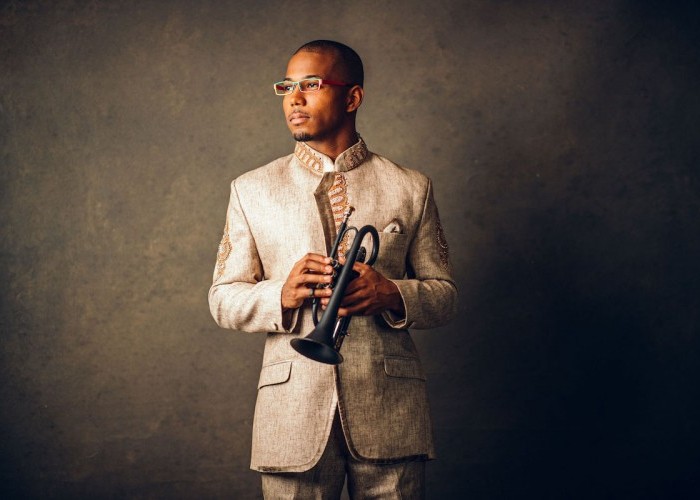Apr 2, 2024 12:59 PM
Saxophonist, Sonic Explorer Casey Benjamin Dies at 45
Casey Benjamin, the alto saxophonist, vocalist, keyboardist and producer who stamped his distinctive sounds on the…

Victor Haskins cultivated his affinity for EWI as a student at Richmond’s Virginia Commonwealth University.
(Photo: Josh Marcus)When trumpeter and composer Victor Haskins teaches young students about jazz, he tries to explain to them that the music is less than a “what” and more of a “how” when expressing ideas. “Everything is centered around driving that point home,” said the Richmond, Virginia-based Haskins after giving a presentation to students at Washington, D.C.’s Oyster Adams Bilingual School this spring.
Haskins, 26, came to Oyster Adams as director of the Kennedy Center’s in-school jazz ensembles program. Students were mostly kindergartners, a situation that in lesser hands could prove challenging, given the level of sophistication and maturity typically required to appreciate jazz.
But the trumpeter believes that by not pandering to his young audience and being honest with them about what he’s teaching, he reaches them more effectively. “Everybody has the capacity to understand things that are complex, difficult or deep,” said Haskins, who also is the director of jazz ensembles at the College of William & Mary in Williamsburg. “So, I just try to present what we are doing in a way that’s very logical and very exciting. And I try to bring in a wide variety of sounds, grooves and ideas that you might hear in any range of jazz music.”
In addition to playing trumpet, Haskins piqued many students’ curiosity by playing an electronic wind instrument; he wanted them to understand that jazz isn’t solely about acoustic instrumentation. Drummer Tony Martucci and bassist Randall Pharr—Haskins’ regular trio mates—joined him for the school presentation.
The bandleader features the EWI prominently on his self-released sophomore album, Showing Up. On the billowing “Grey,” the strutting “Five In The Pocket” and the probing “Psithurism,” Haskins creates striking electro-textures and tonal colors on the EWI that place him in the lineage of trumpeters like Miles Davis, Jon Hassell and Christian Scott aTunde Adjuah, who all have used electronics to articulate and extend their music vocabularies.
The EWI typically is associated with reed players, Michael Brecker being among its more notable practitioners. When Haskins was attending Virginia Commonwealth University in Richmond, many of his friends were into the late saxophonist’s work. “He was an amazing musician, but I wasn’t into Michael Brecker, personally. But I became aware of the EWI through his music,” Haskins recalled.
Haskins sought the sonic explorations of the EWI while conceiving his “Improvi-Story” presentation. He had become frustrated with trying to make the trumpet emit sounds and textures that were beyond its capacity. “I felt like I was trying to fit a square peg inside a round hole,” he said.
Haskins found it challenging to imbue the EWI with some of the more human elements that the trumpet lends itself to: the manipulation of sound through embouchure, facial muscles and the positioning of valves. “Most of the emotional content on the EWI comes from how you design and trigger the individual sound patches,” he explained.
Haskins’ 2013 debut, The Truth, is an acoustic jazz affair. And even though some of the compositions on Showing Up were composed between 2013 and 2014, Haskins wasn’t compelled to release a sophomore album until six years later, partly because he felt that he didn’t have anything worth saying musically. The following year, though, he began exploring the EWI.
In addition to searching for new sounds, he yearned for personal growth, which led him to start going to therapy in 2018. “I realized that I let that sit on the back burner while I was working on music,” he explained. “I realized that I wasn’t completely satisfied with how I was living life, even though I was accomplishing quite a few things professionally. That’s where the title comes from.”
Haskins applied for an arts grant to help fund the making of Showing Up, but didn’t get it. At first, he contemplated that as an excuse to delay the release. But his newfound sense of self-discovery, both personally and professionally, continued to propel him forward.
“I’m in the process of becoming; we are always in the act of becoming,” Haskins said. “So, I decided to make Showing Up as a timestamp. Everything sort of happened when it was meant to happen.” DB

Benjamin possessed a fluid, round sound on the alto saxophone, and he was often most recognizable by the layers of electronic effects that he put onto the instrument.
Apr 2, 2024 12:59 PM
Casey Benjamin, the alto saxophonist, vocalist, keyboardist and producer who stamped his distinctive sounds on the…

“He’s constructing intelligent musical sentences that connect seamlessly, which is the most important part of linear playing,” Charles McPherson said of alto saxophonist Sonny Red.
Feb 27, 2024 1:40 PM
“I might not have felt this way 30 to 40 years ago, but I’ve reached a point where I can hear value in what people…

Albert “Tootie” Heath (1935–2024) followed in the tradition of drummer Kenny Clarke, his idol.
Apr 5, 2024 10:28 AM
Albert “Tootie” Heath, a drummer of impeccable taste and time who was the youngest of three jazz-legend brothers…

“Both of us are quite grounded in the craft, the tradition and the harmonic sense,” Rosenwinkel said of his experience playing with Allen. “Yet I felt we shared something mystical as well.”
Mar 12, 2024 11:42 AM
“There are a few musicians you hear where, as somebody once said, the molecules in the room change. Geri was one of…

Larry Goldings’ versatility keeps him in high demand as a leader, collaborator and sideman.
Feb 21, 2024 10:45 AM
Are you having any fun? Larry Goldings certainly is. Consider just two recent examples:
Scene 1: “If anyone had…